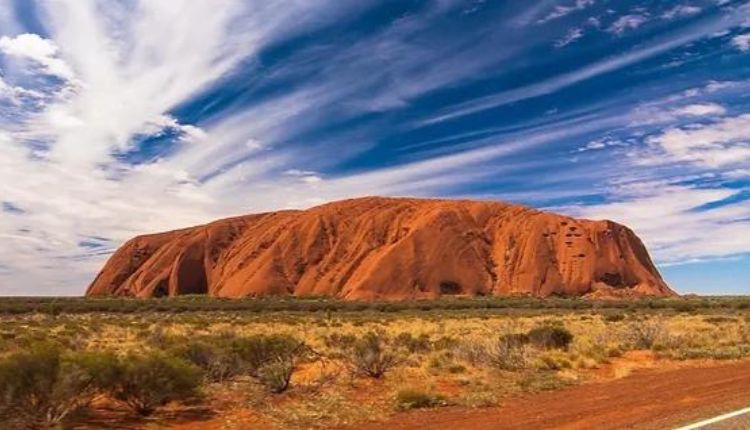Visiting Uluru and Kata Tjuta is one of the most memorable things you’ll do in Australia. It’s a place that sends shivers up your spine and moves you to tears. There’s a lot to do at Uluru-Kata Tjuta National Park – from contemplating its significance to learning about its rich culture. There are also plenty of adventures to enjoy like watching the sunrise and sunset or seeing artist Bruce Munro’s global phenomenon Field of Light.
Table of Contents
Day 1
Known locally as Ayers Rock, Uluru is a massive sandstone monolith in the middle of the desert. It’s sacred to the Aboriginal people and holds a deep and profound meaning in their culture. It’s also a spectacular sight to see at sunrise and sunset, and you will likely find yourself in awe of the changing red hues as the sun rises or sets. The on-site Cultural Centre is a great place to learn about the significance of Uluru and Kata Tjuta, both of which are protected as UNESCO World Heritage sites.
The best time to visit is during winter, when the temperatures are more moderate. This is also when the flora and fauna are in full bloom, so you’ll be able to spot some rare and beautiful creatures. Flights to Yulara (the name of the township at the Uluru-Kata Tjuta National Park) are readily available from most Australian cities. The trip takes between two and four hours.
Day 2
One of the best things to do in Uluru is witnessing the rock formation change color as the sun sets and rises, to know more click here leaveyourdailyhell.com/2023/11/12/how-many-days-in-uluru/. The dusty oranges and reds of the rock are stunning. Many visitors also love to walk around the base of Uluru, taking in the flora and fauna of the desert and learning about the significance of the site to the Anangu people. The full base walk takes about 3 hours and is a great option for those who aren’t looking for a full guided tour.
The awe-inspiring Uluru-Kata Tjuta National Park offers so many jaw-dropping experiences. From exploring windswept gorges to gazing upon starry skies, this magical outback destination is full of enthralling adventures. Other popular activities include quad bike or Segway tours, Aboriginal Bush Tucker Tours and hot air balloon rides.
Day 3
When it comes to awe-inspiring natural landmarks, there are few as spectacular as Uluru and Kata Tjuta. The two sandstone formations are a major highlight of the region and can be seen at their most impressive in either sunrise or sunset. Start your day at the Cultural Centre where you can learn about the significance of the landscape to the local Anangu people. Then join Ken on the Kuniya Walk where he shares one of the most dramatic Creation stories, about the battle between Kunia and Liru.
It’s important to remember that Uluru and Kata Tjuta are sacred places for the Anangu. So be sure to respect their wishes and follow the signs around the national park, including not climbing or hiking to the top of Uluru as many have died in attempts to do so. You should also avoid photographing certain areas of the rock that are sacred to the Anangu and are clearly marked as such.
Day 4
A visit to the eponymous Uluru-Kata Tjuta National Park is a rite of passage for any traveler in Australia. This UNESCO World Heritage Site is awe-inspiring both for its natural beauty and history, and is a hive of activities and experiences. From exploring the windswept gorges of Kings Canyon to learning about the traditional Anangu tribes at the Uluru Cultural Centre, there are countless things to do in Uluru and Kata Tjuta. But, we recommend three days in the Sacred Land to fully immerse yourself in all this wonder has to offer.
Wake up early to see Uluru at sunrise and witness its color changes as the sun plays across the landscape. Later, head to the Field of Light at Uluru, an otherworldly installation of 50,000 solar-powered spindles of lights that twinkle in the shadow of the rock formation.
Conclusion
Ayers Rock Resort (formerly known as Yulara) is the only place to stay within Uluru-Kata Tjuta National Park. A pass to enter lasts three days so it’s best to stay at least a few. Marvel at the otherworldly grandeur of Uluru and Kata Tjuta. It’s particularly spectacular during sunrise and sunset when the rock formations change colour in a magical display.
